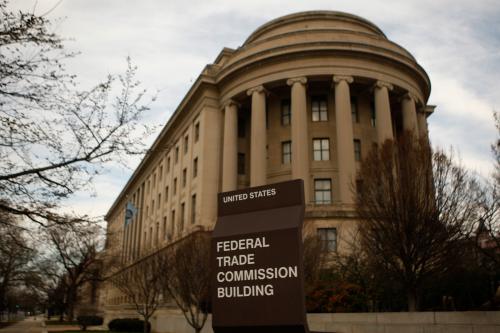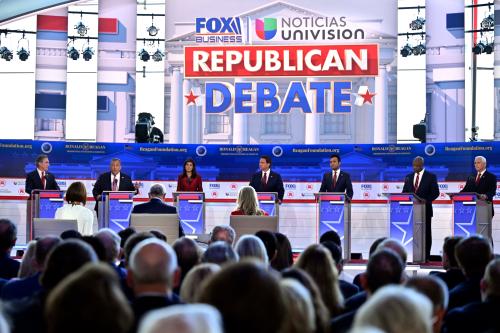On July 9, President Biden signed a sweeping executive order (EO) directing a multitude of federal agencies to promote additional competition in the U.S. economy. One such directive encourages the Federal Trade Commission (FTC) to enact additional regulations that prohibit manufacturer policies barring the repair of equipment and devices by individuals and independent repair shops.
The FTC has already made clear the benefits of granting what is called the “right to repair”—to facilitate faster and cheaper repairs that will ultimately reduce e-waste. While a bipartisan group of lawmakers at the state and federal levels has introduced right-to-repair legislation, this is a good first step. But a more comprehensive federal bill is still needed.
The benefits are clear, but industry practices have not kept pace
Responding to congressional concern that manufacturers may be limiting the possibility for independent repair shops or individuals to conduct their own maintenance and repairs, the FTC in its March 2021 report to Congress agreed with the premise that its regulations have not kept pace with new manufacturer techniques that restrict third-party repair. The FTC subsequently identified several types of repair restrictions, including restrictions stemming from product designs, parts availability, software locks, and end-user licensing agreements that need to be reformed.
Intentionally complex product designs, such as the use of specialized screws, the excessive use of glue inside of a device, or hard-soldered components, can limit the physical repairability of products in the first place. Similarly, limiting the availability of parts, diagnostic tools, and manuals to a manufacturer’s authorized service providers can make it impossible to repair products. Even if consumers or third parties find replacement parts from the original manufacturer, technological protection measures—such as requiring software keys from the manufacturer to reset a device, or requiring a salvaged part to work only with one specifically identified product—can practically and legally prohibit independent repair shops and individuals from making needed alterations. Almost all devices with microchips contain end-user licensing agreements preventing modification or reverse-engineering, which can legally prohibit independent repair shops or individuals from finding repair workarounds to previous issues.
While the FTC found no empirical justification from manufacturers for these restrictions, it did identify meritorious arguments for the right to repair by proponents. These included empirical arguments that the timing and price of repair with independent repair shops were quicker and less expensive than from authorized repair providers, especially in rural areas and among consumers with limited means. An example of this for rural consumers was specifically identified by President Biden in the EO: Farmers often must wait days for an authorized technician, even if the fix is as simple as pushing simple software-restricted buttons. Yet the FTC also identified another key benefit not mentioned in the executive order—the potential reduction in e-waste that the right to repair could bring. While manufacturers have worked to bring down e-waste in the last decade, the potential for longer device lifespans would lead to fewer discarded devices.
The need for more state and federal action
In spite of the benefits of granting the right to repair, Massachusetts stands as the only state to have any right-to-repair legislation since the 1980s, passing ballot measures in 2012 and 2020 that granted rights to independent repair shops to work on cars sold in the state (three states have limited right-to-repair laws—California, Indiana, and Rhode Island—that date back to the 1980s and are limited in time and scope). The initial 2012 referendum required automakers to provide access to diagnostic and repair information, as well as technical updates, to independent repair shops for a reasonable fee. This led to the only right-to-repair memorandum of understanding between any manufacturing sector and independent repair shop trade groups, where all car manufacturers (besides Tesla) agreed to abide by the Massachusetts law in the entirety of the United States in return for the cessation of additional lobbying for right-to-repair legislation by independent repair trade groups. If any subsequent right-to-repair laws were passed in other states, automakers could unilaterally withdraw from the agreement in all states impacted. As the initial memorandum specifically excluded automotive telematics—systems that collect and wirelessly transmit mechanical data to a remote server—the passage of the 2020 Massachusetts referendum requiring automakers to grant independent repair shops access to such services for diagnosis, maintenance, and repair by 2022, has left the agreement in an uncertain place.
Although no state has enacted comprehensive right-to-repair legislation, the Repair Association, an advocacy organization for the independent repair industry, has successfully persuaded a bipartisan set of legislators in at least 32 states since 2014 to introduce bills that include some form of right to repair and some are even comprehensive. Most bills are based on its model legislation template and while there is variation by state in what industries are included, most legislation would require manufacturers of products with embedded digital electronics to make any documentation, parts, and tools provided to authorized repair providers also available to independent repair shops on reasonable terms, including any updates to its firmware. The bill also clarifies that internal components of devices that provide security functions are not exempted, and as such manufacturers must provide equipment and documentation to disable and reset security devices that prevent maintenance or repair.
While many states have such bills stalled or expired, no state legislative chamber has yet approved a bill, with the exception of the recently approved bill in the New York State Senate that appears to have stalled in the Assembly. Rep. Joseph Morelle (D-N.Y.) has similarly introduced near-identical legislation, the Fair Repair Act, in Congress, which for its part excludes both automotive and medical device manufacturers.
More work to do
While the president’s EO is a good initial step, the FTC report clearly demonstrates that more public discussion, followed by comprehensive right-to-repair action at the federal level, is needed. As the FTC points out, there are several issues still outstanding in the Repair Association and Fair Repair Act legislation. If only to preserve the memorandum of understanding between automobile manufacturers and right-to-repair advocates, it excludes the automotive industry in addition to the medical device industry. While there could be merit to these exclusions, other industries—including the video game industry, which has already requested an exclusion—will also want the opportunity to sway lawmakers and the public.
The FTC also points out that future legislation may want to provide a definition for replacement components, as well as potentially provide—as several states have done—a dollar threshold or duration-after-manufacture limits for these rights. Current Repair Association legislation only requires parts granted to authorized service providers to be sold at a reasonable price to independent shops and individuals; Congress, stakeholders, and the public should doubtless weigh in on whether this should include hazardous or dangerous components. Similarly, the FTC report suggests that public and stakeholder comment should be sought on whether to include inexpensive, truly throwaway products in the right to repair. Consumers may not expect to repair—nor manufacturers diagnose—issues with, for example, $5 charging cords, although they would be currently covered.
A potential patchwork of state laws, memorandums of understanding, and limited FTC rulemaking are insufficient to address an issue that impacts essentially all consumers and products sold in the United States. The benefits are clear, and stakeholders and the public deserve the opportunity to provide comment. We hope that the renewed focus on the right to repair from the White House and the FTC also will spark serious action from Congress.
-
Acknowledgements and disclosures
The authors would like to thank Emily Skahill for her research assistance.






Commentary
President Biden’s right to repair order needs strengthening to aid consumers
July 14, 2021